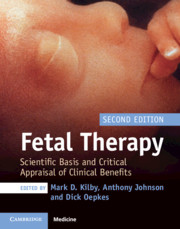Book contents
- Fetal Therapy
- Fetal Therapy
- Copyright page
- Dedication
- Contents
- Contributors
- Foreword
- Section 1: General Principles
- Section 2: Fetal Disease: Pathogenesis and Treatment
- Red Cell Alloimmunization
- Structural Heart Disease in the Fetus
- Chapter 12 Structural Heart Disease: Embryology
- Chapter 13 Structural Heart Disease: Genetic Influences
- Chapter 14 Deciphering the Mechanisms of Developmental Heart Disease: Research from Embryonic Knockout Mice
- Chapter 15 In Utero Intervention for Cardiac Disease
- Chapter 16 Fetal Cerebral Consequences of Structural Heart Disease: Can These Be Ameliorated?
- Fetal Dysrhythmias
- Manipulation of Fetal Amniotic Fluid Volume
- Fetal Infections
- Fetal Growth and Well-being
- Preterm Birth of the Singleton and Multiple Pregnancy
- Complications of Monochorionic Multiple Pregnancy: Twin-to-Twin Transfusion Syndrome
- Complications of Monochorionic Multiple Pregnancy: Fetal Growth Restriction in Monochorionic Twins
- Complications of Monochorionic Multiple Pregnancy: Twin Reversed Arterial Perfusion Sequence
- Complications of Monochorionic Multiple Pregnancy: Multifetal Reduction in Multiple Pregnancy
- Fetal Urinary Tract Obstruction
- Pleural Effusion and Pulmonary Pathology
- Surgical Correction of Neural Tube Anomalies
- Fetal Tumors
- Congenital Diaphragmatic Hernia
- Fetal Stem Cell Transplantation
- Gene Therapy
- Section III: The Future
- Index
- References
Chapter 13 - Structural Heart Disease: Genetic Influences
from Structural Heart Disease in the Fetus
Published online by Cambridge University Press: 21 October 2019
- Fetal Therapy
- Fetal Therapy
- Copyright page
- Dedication
- Contents
- Contributors
- Foreword
- Section 1: General Principles
- Section 2: Fetal Disease: Pathogenesis and Treatment
- Red Cell Alloimmunization
- Structural Heart Disease in the Fetus
- Chapter 12 Structural Heart Disease: Embryology
- Chapter 13 Structural Heart Disease: Genetic Influences
- Chapter 14 Deciphering the Mechanisms of Developmental Heart Disease: Research from Embryonic Knockout Mice
- Chapter 15 In Utero Intervention for Cardiac Disease
- Chapter 16 Fetal Cerebral Consequences of Structural Heart Disease: Can These Be Ameliorated?
- Fetal Dysrhythmias
- Manipulation of Fetal Amniotic Fluid Volume
- Fetal Infections
- Fetal Growth and Well-being
- Preterm Birth of the Singleton and Multiple Pregnancy
- Complications of Monochorionic Multiple Pregnancy: Twin-to-Twin Transfusion Syndrome
- Complications of Monochorionic Multiple Pregnancy: Fetal Growth Restriction in Monochorionic Twins
- Complications of Monochorionic Multiple Pregnancy: Twin Reversed Arterial Perfusion Sequence
- Complications of Monochorionic Multiple Pregnancy: Multifetal Reduction in Multiple Pregnancy
- Fetal Urinary Tract Obstruction
- Pleural Effusion and Pulmonary Pathology
- Surgical Correction of Neural Tube Anomalies
- Fetal Tumors
- Congenital Diaphragmatic Hernia
- Fetal Stem Cell Transplantation
- Gene Therapy
- Section III: The Future
- Index
- References
Summary
Our understanding about the genetic influences on human disease has increased dramatically with the technological developments in genome and DNA analysis and the discovery of the human genome sequence. Whilst much remains unexplained, it is obvious that normal cardiac development is controlled by the genome and there is significant evidence that a proportion of cardiac malformations are caused by genetic factors. This is important for clinicians as an understanding of confirmed genetic factors is essential to estimate recurrence risks of congenital heart disease (CHD) within families and also screen for predicted associated anomalies. An accurate genetic diagnosis can provide important prognostic information for both the initial patient (proband) and other family members, for whom further genetic investigations may be indicated. There is likely to be a continued increase in demand for such investigations as improvement in surgical and medical management allows more individuals with CHD to survive to reproductive age and have families of their own. For some, the recurrence risk for a cardiac malformation may be as high as 50%; the actual figure varies with different genetic diagnoses. Accurate risk stratification is likely to become increasingly important and the rapidly developing technologies to detect genetic variation mean that genome-wide investigation is becoming more widely available in the clinical setting. An aim of this chapter is to introduce clinicians to principles that will help them embrace and understand the results from these investigations and appreciate the implications they have for their patients.
- Type
- Chapter
- Information
- Fetal TherapyScientific Basis and Critical Appraisal of Clinical Benefits, pp. 123 - 132Publisher: Cambridge University PressPrint publication year: 2020

